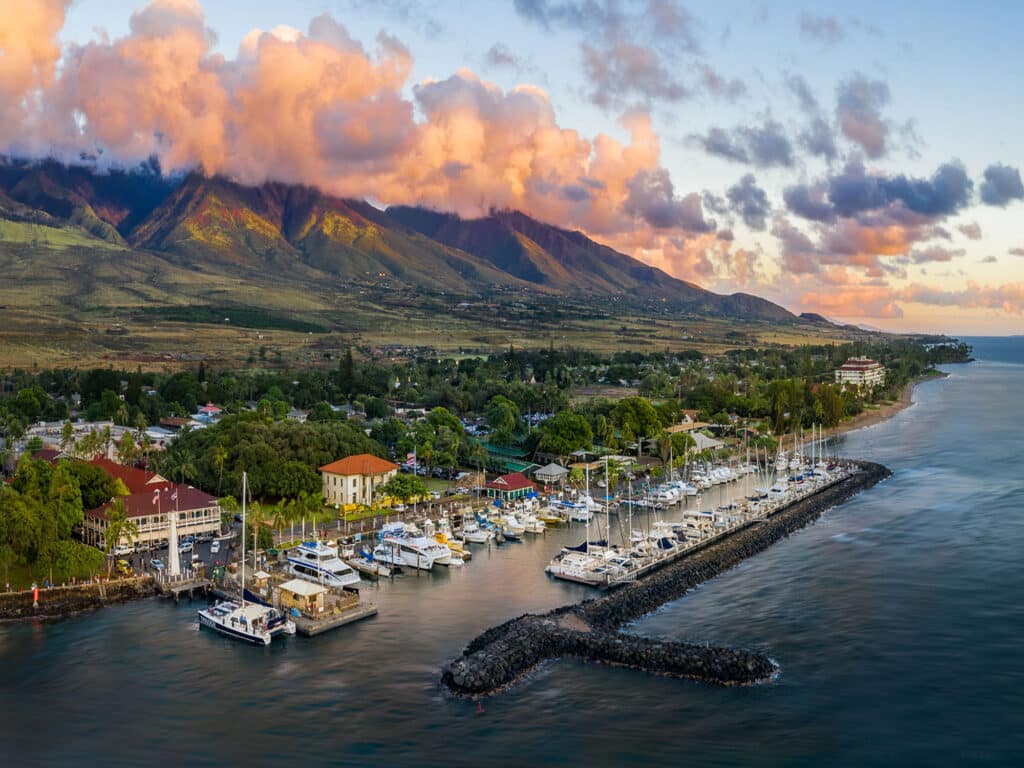
I came to Lahaina from the south. After 13 days on an unleashed reach out of French Polynesia, I clung to the mast top, my legs wrapped in a death grip. We swung west into Alenuihaha Channel, known to Hawaiians as the river of laughing waters. The sun blazed and the trades howled as 20-foot rollers raced up our stern and frothed over the rails. Flying our heaviest chute was risky, as the channel boiled with towering whitecaps, but the Beach Boys blared from the deck speakers, and Maui loomed ahead in all its verdant glory. Cobalt-blue waves cascaded on the approaching lava rocks of Kaupo. Hana stood lush to the east, with the Big Island’s Mauna Loa and Mauna Kea silhouetted to the south.
I hadn’t been back to America in years, and I now charged full-tilt—unvanquished from the south seas under a swollen spinnaker, drunk on Brian Wilson.
It was gnarly up the mast. The horizon was a sweep of white water wrapped along the Maui shore, with roller after roller that threatened to bury us in the troughs. We broached, like a dog shaking a rat on a rope, and I slammed hard onto the deck with the bosun’s chair tangled around my legs. Our keel broke the surface as we buried the spreaders and spun out of control. All of us hung white-knuckled until the boat shuddered violently and tried to stand. We were a seasoned crew, baked brown and stringy by the sun. We hadn’t dropped the chute in 2,000 miles since leaving Tahiti. The closer Maui inched, the more we felt invincible. Landfall does that. After days at sea, every south sea island is an intoxicating rebirth of the senses, a virginal stirring of the heart. Lahaina was all of that. We had the boat tidied by the time we slipped past Kaho’olawe, into the lee of west Maui and the tranquil, humpback-strewn waters between Lahaina and Lanai.
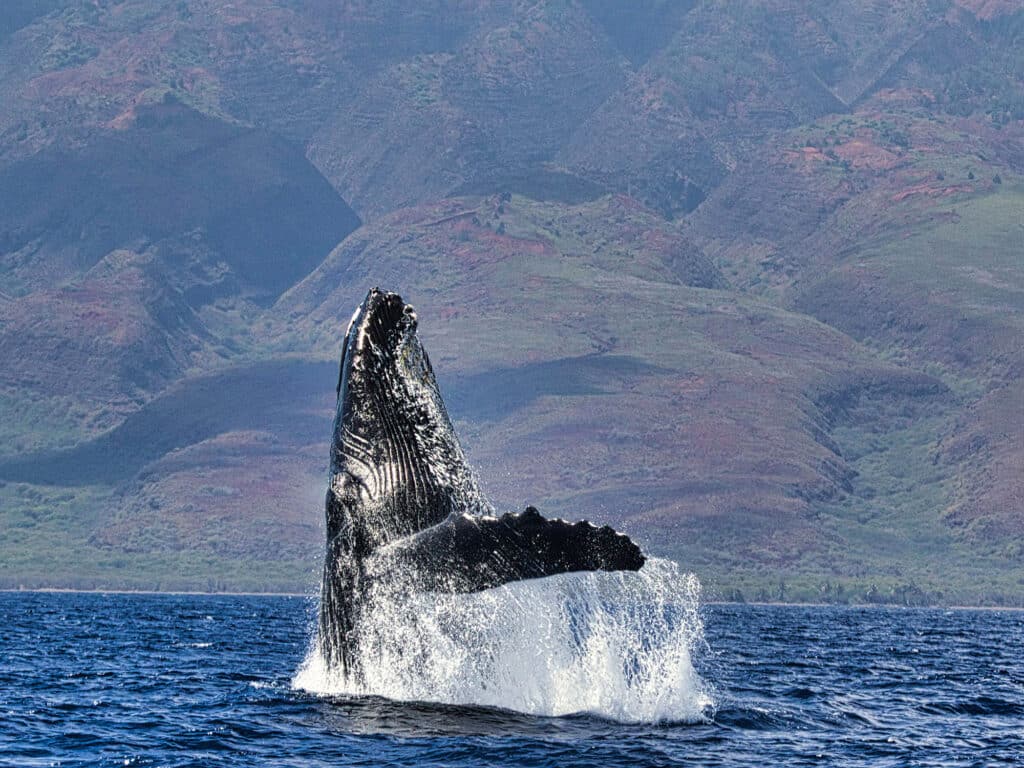
Among cruisers around beach fires back in the South Pacific, Lahaina’s reputation was as a dusty, one-horse whaling town. I was on the beach in Huahine, set to hitch a berth to New Zealand, when “Hurricane Annie” Musselman, a striking female sailor fresh ashore after a 20-day sail from Maui, convinced me of the fun awaiting me in Hawaii, where I could then catch a boat to New Zealand next season.
In Hawaii, an endless arrival of passagemakers and wannabe sailors from the mainland made Lahaina their first stop. Those flying over never felt the same passion for the place; landfall was the only way to fathom the prize of Lahaina. From the sailor’s eye after days on the open ocean, Lahaina offered seduction like no other, bathed in the late-afternoon sunset sweetened by the fragrance of tuberose and mango that wafted miles offshore.
It wasn’t the thought of endless lilikoi cocktails, or the fantasy of tropically toned women exuberant with song and dance, their hair pinned with red hibiscus flowers and with plumeria leis around their necks. Beyond the fertile earth, fresh fruits, waterfalls, perfect surf, and harbor life of ocean sailors was the stunning Hawaiian backdrop and a celebratory welcome for sailors fresh from the sea, dues paid. Welcome to the land of earthly delights.
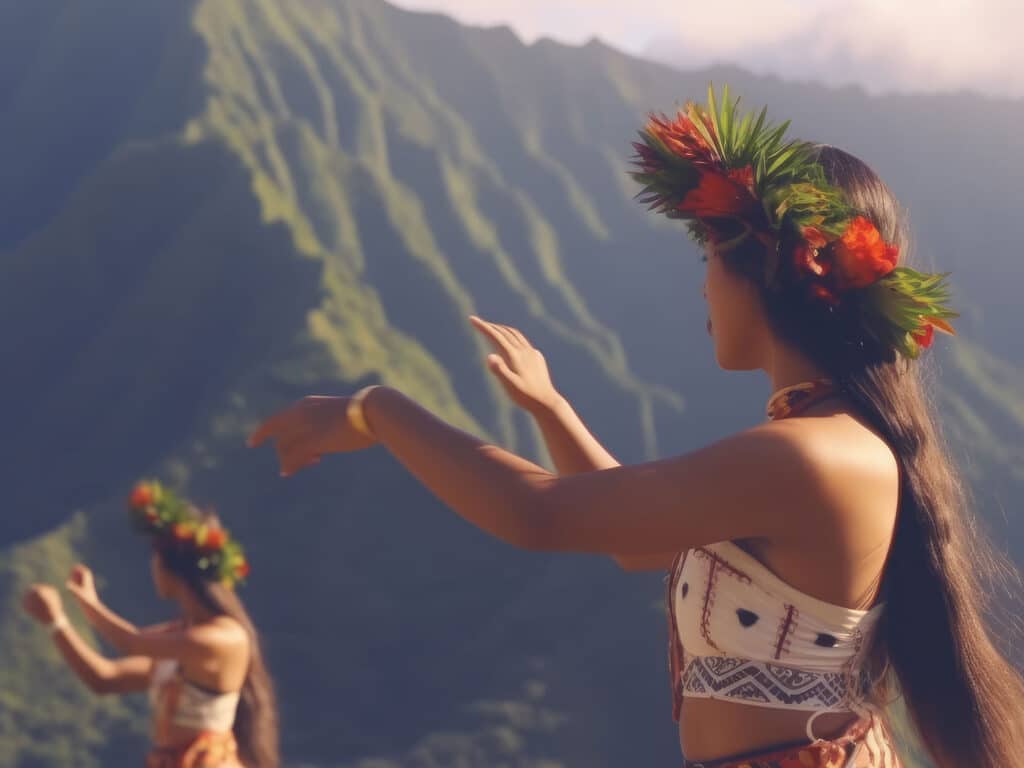
Lahaina’s harbor, first seen as mast tops peering over a small breakwall, was packed with working and provisioning yachts. At the entrance lay a weary 19th-century whaling ship, long in the rigging, and over its shoulder was an old missionary plantation home and museum adorned with whaling artifacts and reminders of the invasion of the Hawaiian Kingdom centuries ago.
The waterfront public library next door was the best place to watch the sunset through the palms, and next to that loomed the colonial, columned veranda of the Pioneer Inn, with its red roof, green sides, creaking wainscoting, whirring ceiling fans, open-air everything, and swinging saloon doors with a carved figurehead standing guard. The sound of a honky-tonk piano player pounding the ivories and wailing rousing tunes drifted from the saloon and across the anchorage, serenading us. Just beyond reach of the saloon was the canopy of an enormous banyan tree spreading a hundred yards in every direction. A missionary gift, it had been planted in 1873 by the widow of King Kamehameha. Lahaina, the capital of the Kingdom of Hawaii, which Kamehameha violently united, became the whaling capital of the world and commanded respect.
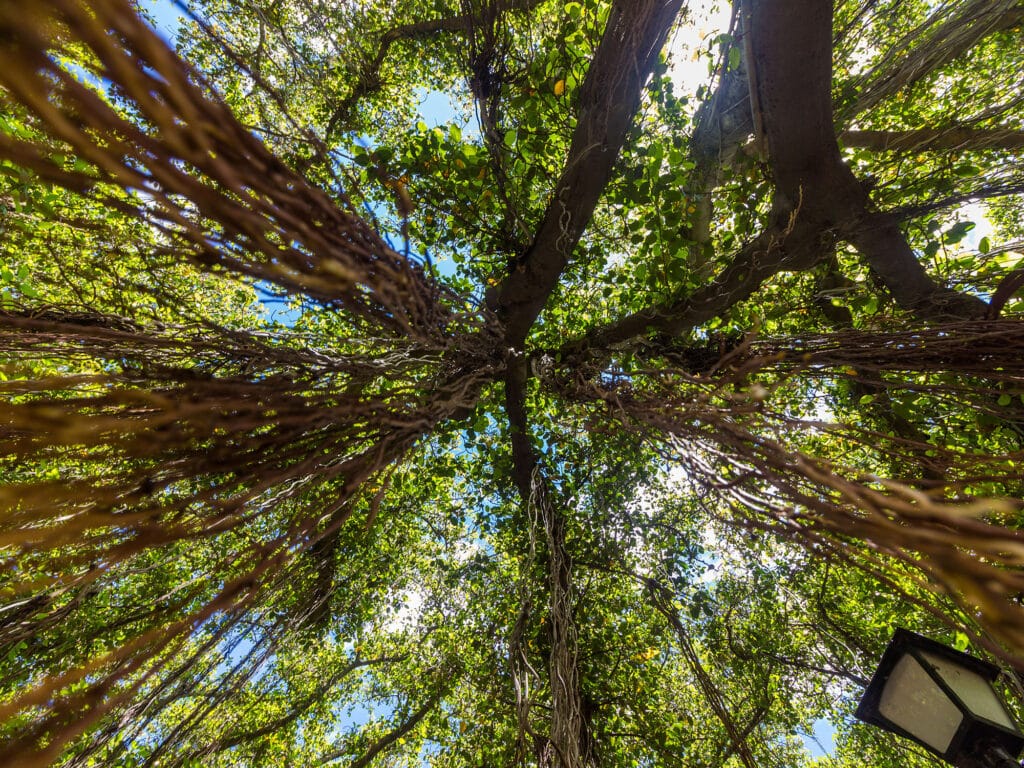
Even with its tin-pan serenades drifting across the water and its promises of revelry ashore, Lahaina was a sacred destination for those crossing the Pacific. Its backdrop was a riotous splash of color—a transformative sight after weeks at sea. Lush green cane fields rose up the slopes behind town, waving in the trade winds like a frozen sea. Red earthen foothills, ascending steep slopes to the majestic cloud-shrouded tops of the West Maui Mountains. Lahaina’s low-slung waterfront foreground bustled with green, shanty-style houses and humble shops all the way to the sugar cane mill, where every so often the sweet bouquet of molasses would blanket the town. Most harbor regulars nursed dreams of sailing to the South Pacific and were stopping just long enough to find a berth on a yacht heading south. Bikini-clad gals hawked sailing charters while gruff, unshaven sport-fishermen pitched billfish hunts. Sunset-cocktail-excursion captains, in bright-white uniforms with golden epaulets, recruited passengers. Sport divers in wetsuits hauling scuba tanks joined in the shouts amid the beer-drinking revelries of black coral hunters, stewed in their constant highs from too many daily 300-foot dives.
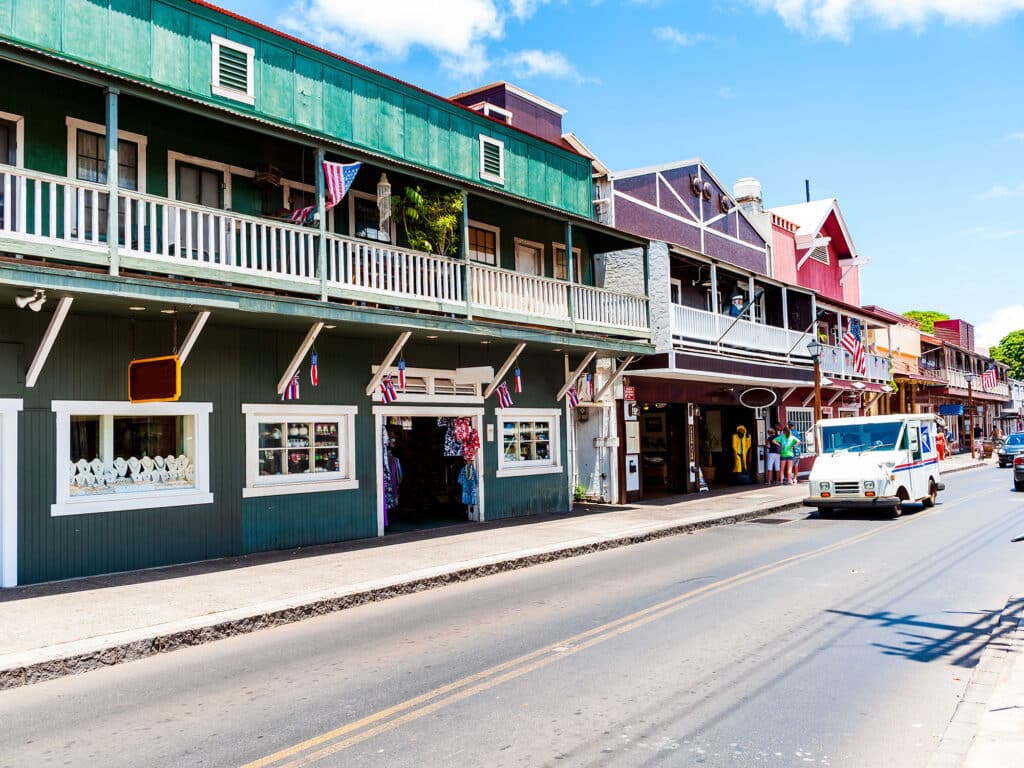
Lording over it all, doling out privileges and access like a pirate king, was the leather-skinned, gray-bearded harbormaster. The rest of the town was second fiddle to the workings of that tiny harbor, the heartbeat of the town. Inebriated or not, the harbormaster could make or break sailing futures in this part of the Pacific. Flippant declarations boomed from the breakwall as he stalked the docks, banishing boats from the harbor, relegating them to endless hobbyhorsing at anchor, scheduling impossible departure times, and controlling the pace of work and supplies to replenish desperate sailors amid bribes, favors, and hard-luck tales.
A steady stream of entrepreneurs, street hustlers, harbor alcoholics, and starry-eyed youthful adventurers were always coming and going, convinced that they were at a pitstop en route to the South Pacific. Seemingly every waiter and waitress had dreams of being discovered, landing a berth on a boat heading south.
For many other locals, content with their hospitality and construction jobs, Lahaina was just home. Several hundred one-story houses of all shapes and tropical colors led from the water’s edge to the hillsides by the mill, sprawling neighborly toward the Kaanapali beaches to the north and the Olowalu beaches to the south.
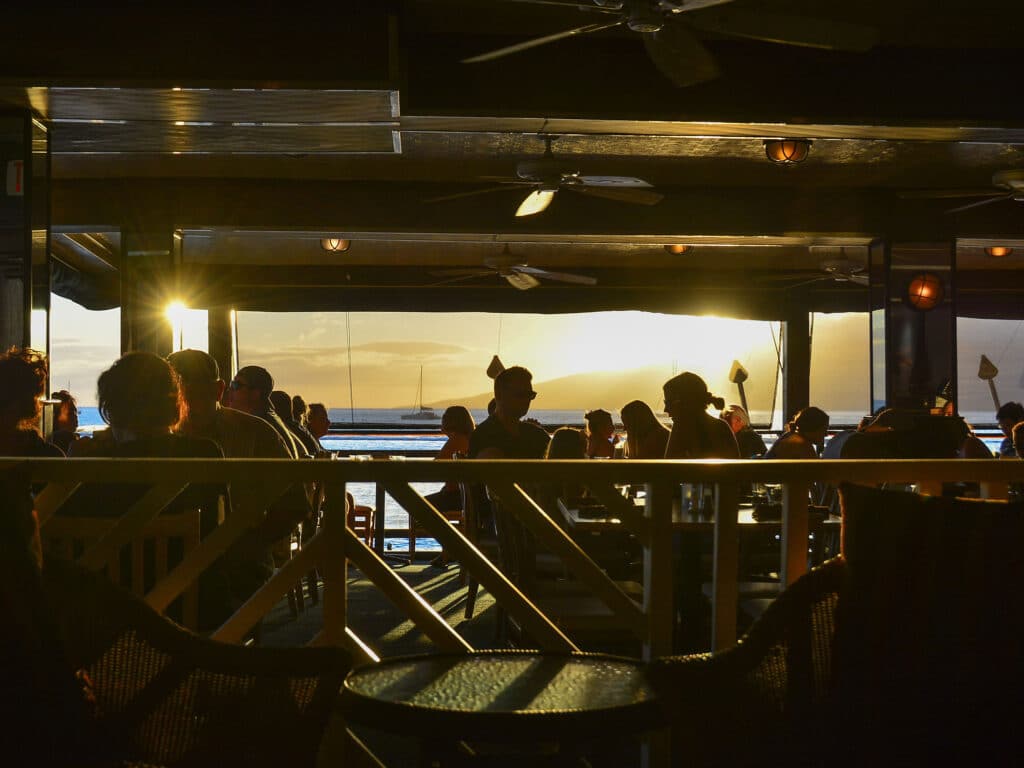
Kaanapali, with its stretch of high-rise beachfront resorts, kept a good distance, about 4 miles from the hum of Lahaina, so their pampered guests could join the tourist hordes swarming town and then return to the civilized world of luxury Hawaiian resorts.
By contrast, many of Lahaina’s simply constructed neighborhood homes had basic tin roofs and green plywood sides, and were smart with a humble pride of ownership. Most houses had flourishing window boxes, and were peppered with hibiscus and plumeria hedges under the shade of towering mango and avocado trees with sweet gardenias, all thriving with minimal care. There was no need for heat or air conditioning, or even screens, in these homes. The streets were alive with locals and young folk making ends meet in town. Dogs barked, kids played, barbecues were everywhere, and bicycles were fine for getting around.
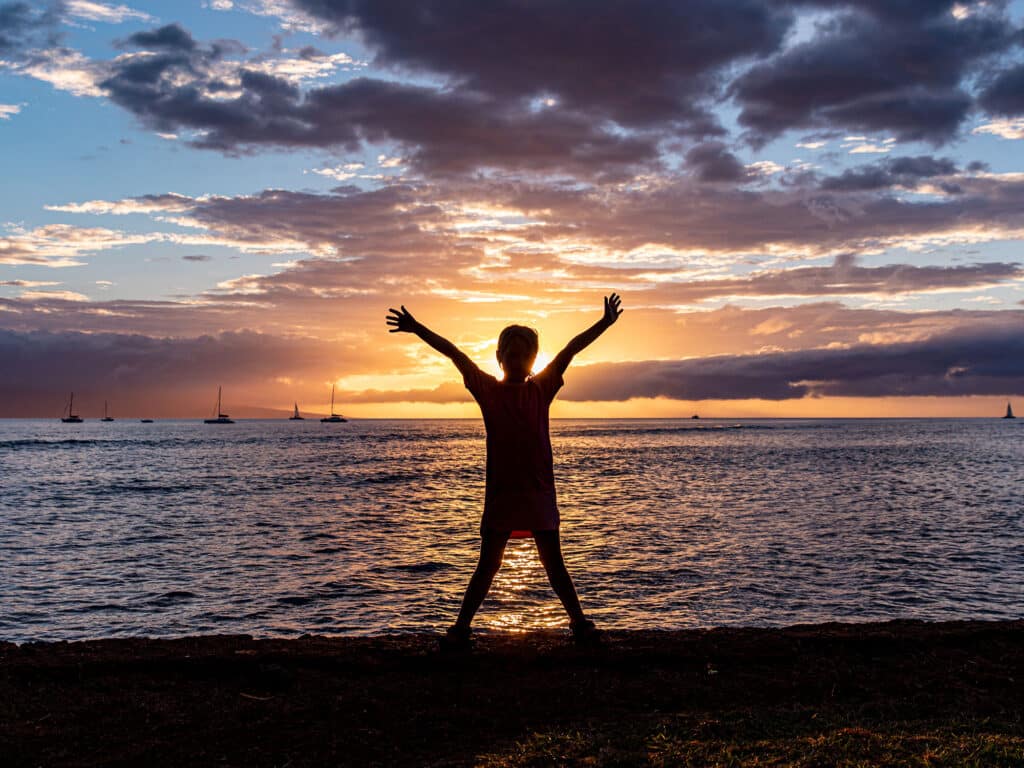
Kids wearing flip-flops and swimsuits skateboarded by the park or pedaled banana-seat bikes through town to the harbor break with surfboards under their arms. Pickups were the vehicle of choice, practical work vehicles suited to racing though cane fields. They’d cruise through town, tunes blasting with surfboards piled high, heading to the beach. Older locals surrounded by their broods of kids and grandkids hosted hula dances and strummed ukuleles beneath the banyan tree, or at the beach or grassy town parks, picnicking to beat the heat.
Lahaina was a tropical mecca of American pizzazz, where mainlanders swapped tales of the South Pacific. With the romance of the south seas under my belt, I was in no hurry to go back to sea, so I ran sailboat charters from here on a handful of yachts from 40 to 65 feet long that swept tourists off the beach for a heart-stopping sprint out to the Pailolo Channel wind line. We got a charge exciting the passengers, shifting without warning from a gentle, drink-sipping 7-knot drift to a rollicking, heeled-over, mai-tai-be-damned 15-knot dash into the teeth of the trades. If the passengers did not seem like they could handle the wind line’s excitement, we sailed calmly to Lanai’s Manele Bay, stopping halfway for a swim with the whales.
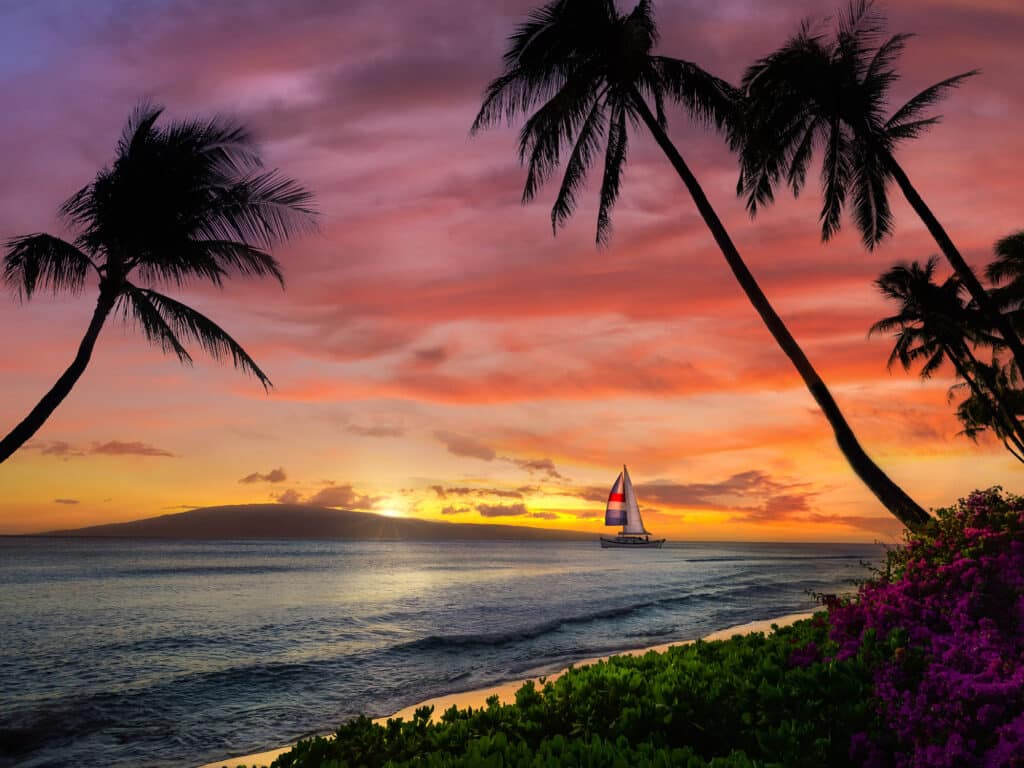
The real charter yachts were too big and too busy to handle the daily traffic in and out of Lahaina Harbor, so we sat on moorings off the resort hotels. There was Johnny Weismueller’s 60-foot 1929 schooner, Allure; Barry Hilton’s Alden 57, Teragram; the 54-foot aluminum ketch Minset; the Hermaphrodite schooner Rendezvous; and a handful of performance catamarans, which had the best layouts to accommodate hordes of tourist passengers, complete with midship bars, and could be rammed right onto the sand for loading and offloading. And the charter fleet wasn’t the only thing humming with intensity and tourists: Lahaina’s Front Street, the town’s waterfront artery, was the place to be. You could grab a drink at the Blue Max—a tiny, second-deck bar overlooking the seawall—and discover Elton John playing a surprise session on the piano. Jim Messina might drop in to perform at Kula’s Silversword Inn; Taj Mahal could be seen playing the congas to an empty beach at sunset; and Stephen Stills and David Crosby were regularly jamming aboard their boats at anchor. I recall Peter Fonda’s 73-foot sloop, Tatoosh, returning from the Marquesas, where I had recently shared trails with its crew while hiking the Nuku Hiva jungle. There were celebrities everywhere on Maui, a place where they could enjoy themselves without facing fandom.
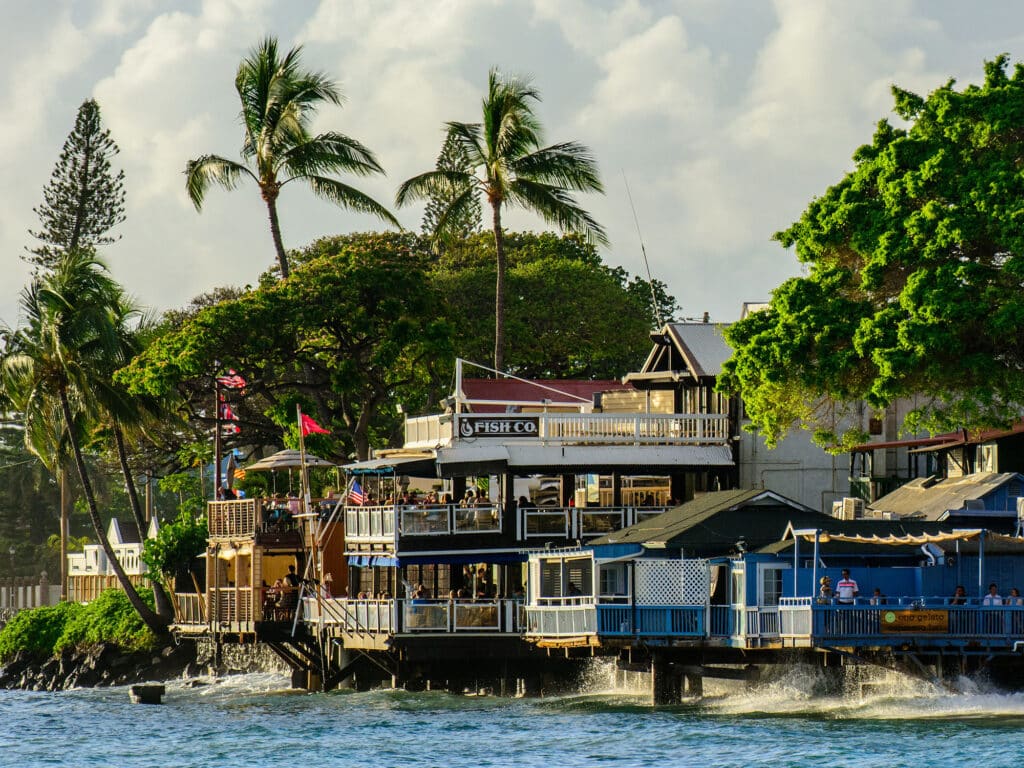
One weekend, we filed aboard the square-rigged Rendezvous with friends and sailed to Oahu to hear the Eagles play Diamond Head crater. Days later, we rounded up our festival-weary crew for a quiet sail back to Maui. Getting around the islands was as easy as going down to the harbor and sticking out your thumb. One friend stood at the harbor entrance and hitched a ride on a sport-fishing boat heading to Oahu. He planted himself in the fighting chair and opened his paperback, ready for a nice read. Next thing he knew, the crew had hooked into something. They grabbed his book, strapped him in, and handed over a live rod. He spent the next four hours landing a 750-pound marlin for the first-ever fish thrill of his life.
Most of the Maui charter boats dragged lines just in case. They often landed ono, mahi, ahi and billfish. Once ashore, they would sprint to the best seafood restaurant in town and pocket a few hundred extra dollars for the crew. I recall a wedding sailing charter aboard Minset around Molokai’s Mokuhooniki Rock that double-hooked two big ono. After the wedding party fought and landed both fish, they returned to the dock bloodied, drunk and still smiling, with rave reviews.
The break at the harbor entrance was sweet enough to lure sunrise surfers from upcountry, a 30-minute drive from the volcanic slopes of Haleakala. As thick as tourists were in town, Lahaina’s waterfront shops had to cater to them. Along with its bounty of missionary folklore and whaling nostalgia, open-air bars, dive shops and salad bars, Lahaina sold trinkets, T-shirts, ice cream, Hawaiian-style jewelry, and the sort of faster food that tourists craving the hotel pool could quickly sample.
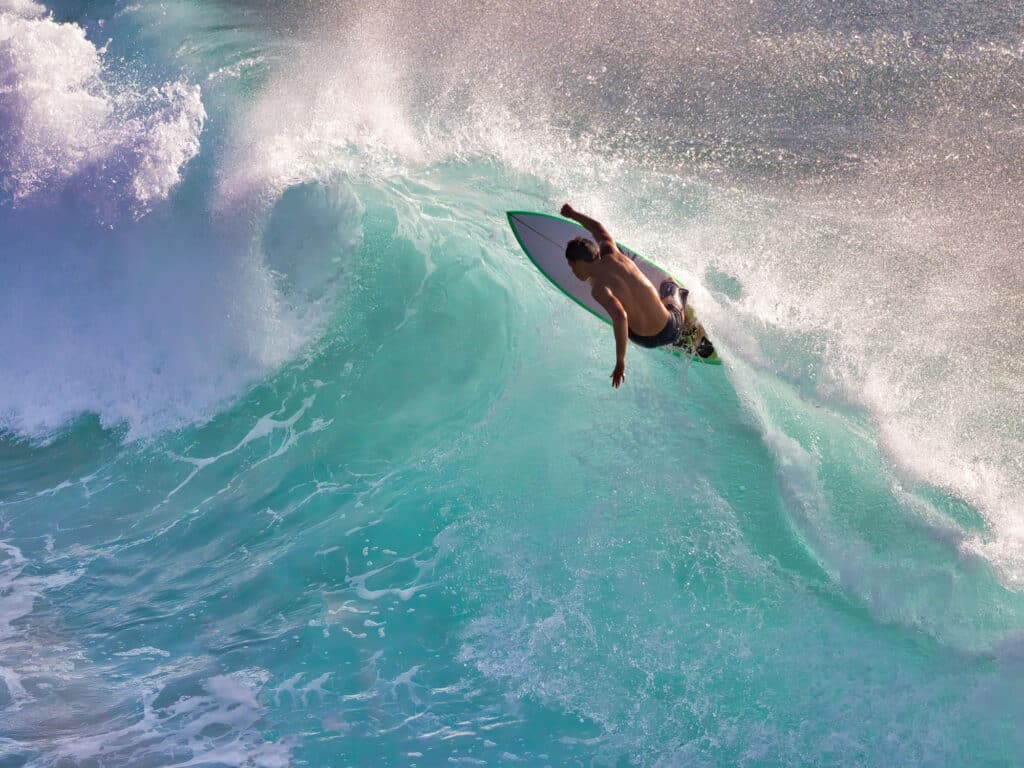
Around it all were the locals, living a life in the seams of tourist traffic, enjoying a shady beachfront tuft of palms and greenery, sitting with relatives on the sand, eating fish packets and coconut rice on the seawall. The proprietary goods that they depended on were relegated to tired one-story shopping centers on the periphery of town. The tourists came and went; it wasn’t difficult for residents to still feel a sense of steadfastness to Lahaina town. They tolerated the young people who moved in to take their hotel and tourism jobs. Compared with the relentless tide of visitors who abandoned their sensibilities when they became tourists, sailors often arrived with purpose and were commonly the most welcome of outsiders.
The famed Lahaina Yacht Club, host of the Victoria to Maui race and open to all visiting yachtsmen, was as unpretentious as there ever was a yacht club. It hosted none of the functions that typical yacht clubs host; it had no docks, no sweeping nautical lobby. Accessed through an insignificant Front Street doorway, the private club was disguised so well along retail row that visitors rarely found it on their first attempt. Inside, the dark, narrow hallway was decorated with photographs of classic sailboats finishing the Transpac and Victoria-Maui races, and framed letters from appreciative yachtsmen. A basic waterfront bar hung over the water with an intimate collection of tables. Dangling from the ceiling were burgees from visiting yachts from all around the world; upstairs, the loft had a few tables and backgammon boards. I participated in a couple of the Victoria-Maui races, as well as the dockside parties afterward. The bright-eyed patrons greeted us at all hours like heroes returning from the sea, offering flowered leis for each sailor, champagne, and lots of fresh fruit and pupus.
It’s an ecstatic moment for racing sailors, but cruising sailors wear their hearts on their sleeves and their first landfall is like a first kiss that can never be repeated. It’s a taste of wonder and redemption, almost salvation from any miscues of the passage, and a gratitude for an ocean’s drop of grace. In racing, the motivation is victory, the mission is speed, and glory the reward. While that’s a thrill worth seeking, in cruising, the promise of landfall is all heart.
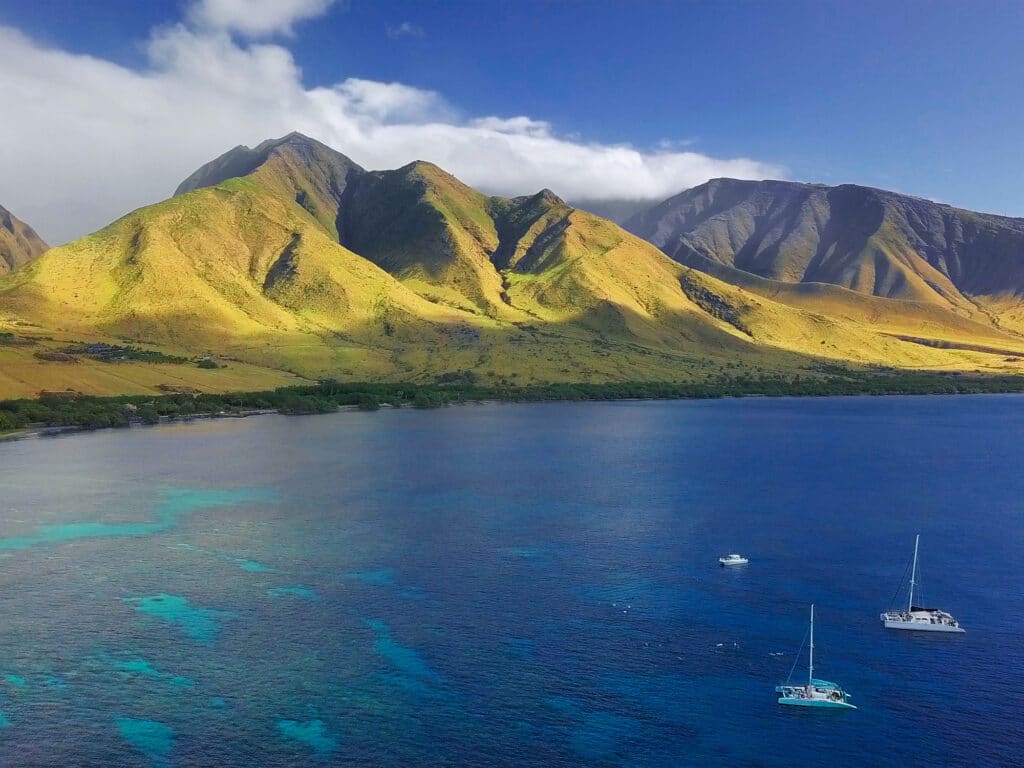
The aching loss for this breathtaking Pacific landfall is that it will never be the same in Lahaina. The sailors will still come, but the landscape and the romantic legacy of a town that was an authentic kingdom’s home, a whaling mecca, a missionary post, and a working blend of tourism and local ohana is gone. What now remains of this legendary alluring paradise is but a barren gray stretch of ashen slabs and ghosts.
The town will be rebuilt and redefined by developers, legal setbacks and the buying power of realtors, but the soul of this Pacific pit stop and the prevailing Hawaiian spirit is at risk. The magic of this mythical landfall will never be quite the same.
Neil Rabinowitz is a longtime and frequent contributor to Cruising World as both a photographer and a writer. His work has appeared in Men’s Journal, Sports Illustrated, National Geographic, Outside, and The New York Times to name a few, and just about every marine publication. He has completed numerous ocean passages on both racing and cruising yachts and often finds inspiration recalling the romance of his first south seas landfall. He lives on a sunny farm on Bainbridge Island in the Pacific Northwest.








